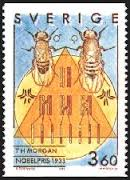Neonicotinoids are subjected to vigilance because of environmental contaminations and deleterious effects on bees. Imidacloprid (IMI) is one of the most representative insecticides of this family. At chronic exposure, concentration-effect relationships are non linear. An insect model should allow a better description of this toxicity. We compared the lethal concentration 50% (LC50) of IMI for a Drosophila-field strain, after acute and chronic exposure. Relative to the acute LC50, the chronic LC50 was lowered by a factor of 29 for males (1.3 mM/45 µM), 52 for larvae (157 µM/3µM) and more than 172 for females (>3.1mM/18µM). Chronic exposure also revealed significant lethal and sublethal effects, at concentrations 3-5 orders of magnitude lower than the chronic LC50. Mean mortalities reached 28% (at 3.91 nM) and 27% (at 39.1 nM) for females and males, respectively. Fecundity decreased of 16% at 1.96 nM. Mating increased of 30% at 0.391 nM. The LOEC (Lowest Observed Effect Concentration: 0.391 nM) was 46000 times lower than the chronic LC50 for males; it was 115000 times lower than the chronic LC50 for females. This study illuminates effects that neonicotinoids can induce at very low concentrations. This is of particular interest for non-target insects and for insect dependent species.
Source: Gaël Charpentier , Fanny Louat , Jean-Marc Bonmatin , Patrice André Marchand , Fanny Vannier , Daniel Locker , and Martine Decoville. Lethal and sublethal effects of imidacloprid, after chronic exposure, on the insect model Drosophila melanogaster, Environ. Sci. Technol., Just Accepted Manuscript DOI: 10.1021/es405331c
Publication Date (Web): March 3, 2014
http://pubs.acs.org/doi/abs/10.1021/es405331c

- Log in to post comments
